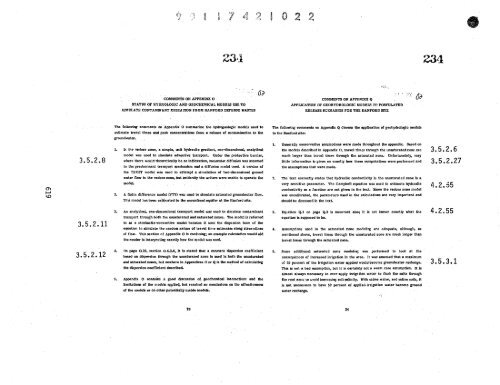EIS-0113_Section_11 - Hanford Site
EIS-0113_Section_11 - Hanford Site
EIS-0113_Section_11 - Hanford Site
Create successful ePaper yourself
Turn your PDF publications into a flip-book with our unique Google optimized e-Paper software.
k'r<br />
231.E 234<br />
COMMENTS ON APPENDIX O<br />
STATUS OF HYDROLOGIC AND GEOCHESRCAL MODELS USE TO<br />
SIMULATE CONTAMINANT MIGRATION FROM HANFORD DEFENSE WASTES<br />
63<br />
COMMENTS ON APPENDIX Q "a<br />
APPLICATION OF GEOHYDROLOOIC MODELS TO POSTULATED<br />
RELEASE SCENARIOS FOR THE HANFORD SITE<br />
The following comments on Appendix O summarize the hydrogeelogie models used to<br />
estimate travel Omer and peek concentrations from a release of contamination to Me<br />
The. fallowing eommente on Append& Q discus the application of ,wbyd,o1.gic models<br />
to the <strong>Hanford</strong> site:<br />
ko<br />
3.5.2.8<br />
3.5.2.<strong>11</strong><br />
1. N the seduce zone, a simple, unit hydraulic gradient, ane-dimensional, arelytical<br />
model was used to simulate edveative transport. Under the protective barrier,<br />
where More would theoretically be no infiltration, molecular. diffusion was assumed<br />
to the predominant transport mechanism and a diffusion model used. A version of<br />
the TRUST model was. need to attempt a simulation of two-dimensional ground<br />
water Row in the vedose zone, but evidently the writers were .able to operate the<br />
model<br />
2. A Mite difference model (VTT) was used to nlmulate saturated groundwater flow.<br />
"In model has Been calibrated to the uneontimed aquifer at the <strong>Hanford</strong> site.<br />
3. M snalfica4 one-dimensional Gems o t model wen used to simulate .nlaminenl<br />
tremport through both the accelerated and saturated canes. The model is referred<br />
to as e st.basti.-cor native model becouae. it tires the dispersion term of Ran<br />
equation to simulate the random nature of travel time estimates along streamlines<br />
of Dow. This section of App.dlx 0 is confusin,; on exasple calculation would aid<br />
Me reader in interpreting exactly how Me model was need.<br />
1. Generally aoreervetive m uman,tioaa were made throughout the appendix.. Based on<br />
the models described In Appendix .O, travel times through the unsaturated zone are<br />
much larger than travel Umes through the saturated zone.. Unfortunately, very<br />
little information is given oa exactly now these compum6ons were performed and<br />
the assumptions. Net were made.<br />
2. The text correctly states that hydraulic conductivity In the unsaturated Zone Is a<br />
very sensitive parameter. The Campbell equation was used to estimate hydraulic<br />
conductivity an a function are not given in Me text. Since Me vedose Zone model<br />
was .calibrated, the parameters used to the calculations are very important sad<br />
should be discussed in the text.<br />
3.5.2.6<br />
3.5.2.27<br />
4.2.55<br />
3. Equation Q.1 oa page Q.3 is incorrect also; it is not known exactly what the 4.2.55<br />
equation is supposed to be..<br />
4. Assumptions used in the saturated came modeling are adequate, .1M.gb, as<br />
mentioned above, travel itmes through the unsaturated... ere much longer Man<br />
travel times borough Me saturated...<br />
4. On page 0.33,. section 0.4.3.6, It is stated Mat a reactant dispersion coefficient<br />
3.5.2.12 based on dispersion through the acculturated Zone Is need In both the unsaturated<br />
and saturated zones, but nowhere in Appendices 0 or Q is Me method of calculating<br />
the dispersion coefficient described.<br />
S. Append ix O rentairm n good discuslm, of geoehemteal interactions and Me<br />
limitations of fire models. applied, but reached no conclusions an the effectiveness<br />
of Me models or an other potentially usable models.<br />
5. Same additional saturated name modeling was performed to lack at Me<br />
onre roamers of increased Irrigation N no Brea. h was ...ad that a maximum<br />
of 20 percent of Me Irrigation water aaplied would become groundwater recharge. 3.5.3.1<br />
This is hot a bed asumptioy but It is certainly not a worst a.. esumptlon. It is<br />
Almost always necesery to ewxrapply hvigatiou water to flush Me setts through<br />
Us root zone ro evoid Increasing soil salinity. With saline water, and saline. soils, it<br />
I. not uncommon to have 50 pereent of applied[ irrigation water become gru.d<br />
water recharge<br />
23 24

















